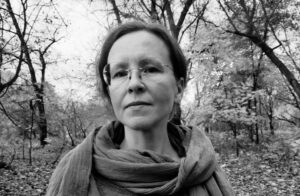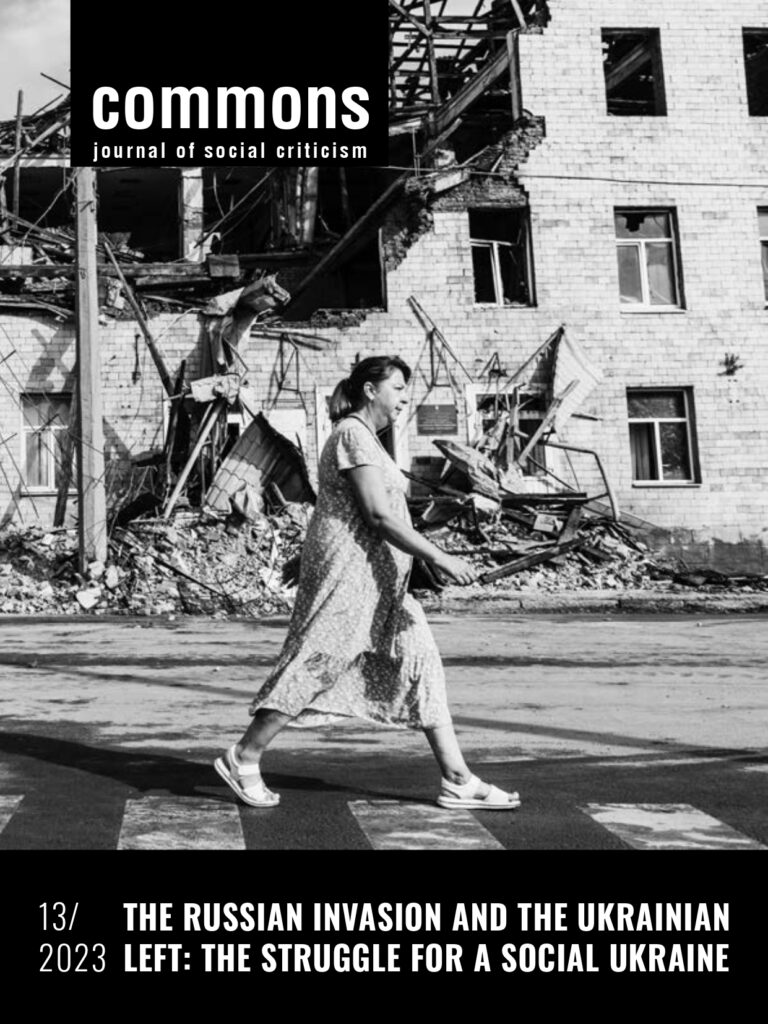Self-Organization and the New Left in Ukraine
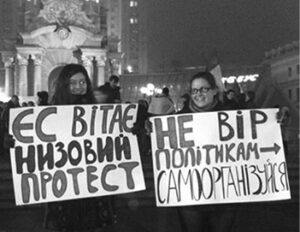
The author (right) on Kyiv’s Independence
Square. December 2013.
In early December 2013, I found myself on Kyiv’s Maidan Nezalezhnosti (Independence Square), holding a sign reading “Don’t Believe Politicians—Self-Organize!” as part of a protest with a small group of student activists. Weeks before, then-president of Ukraine Viktor Yanukovych had refused to sign an Association Agreement with the European Union. This Association Agreement would have integrated Ukraine’s economy more closely with the EU’s, and most people hoped that, by extension, Ukraine’s democratic political system would be strengthened. At the last minute, when he was already in Vilnius to sign the agreement, Yanukovych refused. European governments had implored him to release his former political opponent, Yulia Tymoshenko, from prison so she could seek medical treatment in Germany. Yanukovych would not approve her release, and in Vilnius, he announced that he would instead accept a Russian proposal to join Vladimir Putin’s Customs Union (along with Belarus and Kazakhstan). Putin also promised Yanukovych $5 billion in cash aid instead of the loans and development grants that EU institutions were offering.
While Yanukovych had worked to consolidate power as president, he did not have the authoritarian control that Putin did in Russia. When he refused to sign the Association Agreement, hundreds of people came to Kyiv’s Maidan Nezalezhnosti to protest his decision. The initial protests were largely driven by student activists, including those with whom I was doing research in Ukraine. As a whole, students hoped eventual European accession would improve the quality of Ukrainian education as well as allow them the chance to study more easily in European universities. Ultimately, the protests would move far beyond this focus on Europe, and hundreds of thousands of people would join students in their condemnation of the use of violence against protesters.
Who Is the Left in Ukraine?
Ukraine became independent from the Soviet Union in 1991. In the early part of the 1990s, leaders focused on building the new government, as well as navigating the country’s relationship with major powers—the United States, the European Union, and, of course, Russia. After generations of Russian influence, beginning during the Russian imperial period and continuing through the Soviet Union, Ukrainian national identity was also a key focus after independence.
As an anthropologist in Ukraine to study the student activist movement, I was interested in higher education reform and how student activist groups navigated an increasingly authoritarian, pro-Russian government in Kyiv. The activists who contributed to my research were born around the time of Ukrainian independence. They did not experience the lived realities of state socialism, but they did grow up in the chaotic period of the 1990s. Most of them did not grow up around political ideas that would be considered part of an ideological left, because Ukrainians were distancing themselves from socialist ideas. However, they were all able to find their way to various leftist political positions by the time I met them in 2012 and 2013.
Many of them told me they developed their political ideas in 2004. The presidential elections of that year featured well-documented electoral fraud that worked in favor of the very same Viktor Yanukovych whose decisions would push mass protests almost ten years later. Known as the Orange Revolution, mobilizations in 2004 brought pro-European leader Viktor Yushchenko to power. But Yushchenko was unable to implement most economic reforms because of power struggles with his former allies—such as Yulia Tymoshenko—as well as his former rival, Viktor Yanukovych. While these protests are called a revolution, they were organized around one specific political candidate, and his failures led to the widespread disappointment of its participants.
This disappointment was key to motivating young students who participated in my research to find other avenues for political engagement. Some of them became active within their universities, finding their way to others who wanted to advocate for students’ rights. Others noted the rise of right-wing violence in the 2000s and wanted to fight against its perpetrators. Still others were involved with punk music and discovered leftist ideas within that scene. And some were readers of leftist political thought, ranging from Marx and Engels to Russian anarchist Peter Kropotkin to leftist psychoanalyst Erich Fromm.
Together, the Ukrainian left that was active in 2013 was a diverse group of people with different motivations and different interests in political action. While they did not present any kind of unified leftist position when the protests began, they were able to influence how the protests developed through their idea of self-organization.
Leftist Roots of Self-Organization
From the beginning, leftist student activists saw the political potential in these protests. In their earliest days, I joined leftists to hand out fliers that advocated for self-organization alongside self-determination, arguing that Ukraine’s status in Europe would not be economically equal to other countries, even its neighbors such as Poland or Czechia. These fliers urged protesters not to fall into political camps but to reject the exploitation of the global capitalist system that pitted different groups against one another instead of creating the space to unite against the ruling elites.
Leftists had reason to intervene in these early days. Even as they wanted to support the protests in late 2013, they also wanted to make sure that participants did not simply rally around one political figure, who would surely be a disappointment in the long run. Leftists advocated for self-organization because it avoided existing political parties and empowered people of various political beliefs to participate in the protests.
At its most basic level, self-organization is the idea that if something needs to be done, and someone is able to do that thing, then they should simply do it. They should not wait for a political figure to intervene on their behalf—even if the thing that needs to be done is the responsibility of a political figure or institution. This way, self-organization does not need the support of political parties but has the potential for more horizontal political participation.
Leftist students had been self-organizing throughout the 2000s, creating a foundation for the practice. Ukrainian universities had official student unions, but these institutions were typically the mouthpieces of the university administrators, who were nearly always appointed by the Minister of Education. In other words, official student unions were most likely to represent the Ukrainian government’s position. They were not there to advocate for student rights. When student rights were routinely violated, leftist activists from the independent student union Priama Diia (Direct Action) self-organized to advocate for students in the face of these university administrations. They fought for anything from lower student fees and higher student stipends to 24-hour access to dormitories. While they did not win every fight, they became a strong political force, and their independence from existing political structures lent them legitimacy.

Pro-European student protesters gather at Kyiv-Mohyla Academy, November 2013. Photo by E. Channell-Justice.
When the Kyiv protests on Maidan began, these leftist students and Priama Diia activists promoted self-organization because they wanted to use their experiences working outside the political system to be more effective. They also were aware that their leftist political beliefs were not usually welcome in Ukrainian political society. Often accused of affiliation with the Communist Party or with nostalgia for the Soviet Union—both of which were almost never accurate descriptions of these activists—self-organization was a tactic leftists could share that would allow them to participate without being defined by leftist political beliefs.
Against a Police State: How the Maidan Protests Responded to Violence
On the night of November 30, 2013, riot police (Berkut) beat and arrested students who were camped out on Maidan. Until that night, most of the protest signs and chants had been about Ukraine being part of Europe. The attack on students prompted more people with varied backgrounds from across the city to come to the square to condemn the police for their actions. Leftists created banners calling Ukraine a “police state,” language that resonated with protesters because it was calling out the Yanukovych regime and his allies while not having a particular right, left, or center political position.
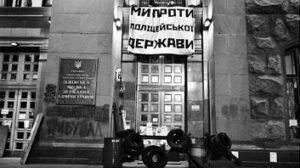
A sign reading “We are against the police state” hangs outside of the occupied City Hall in Kyiv. Photo by E. Channell-Justice.
Fighting against the police state allowed for a broader participation of self-organized activists in a variety of spheres. Student activists, for example, rallied at different universities over the next months of protests, ultimately forcing administrations to agree not to punish students for participating in the mobilizations. When Maidan activists occupied the Ukrainian House (a convention center just outside the central square), students created the Student Assembly in that building to plan demonstrations and student-led interventions. In late February, when the mobilizations turned violent around Maidan Nezalezhnosti, students occupied the Ministry of Education and Sciences after Yanukovych’s pro-Russian minister of education, Dmytro Tabachnyk, fled the city. In all of these, students did not allow the participation of political figures or parties. Indeed, early efforts of political parties to co-opt the student protest body into party-based action was unsuccessful and unwelcome.
Leftists and activists in Priama Diia traced self-organization to leftist political ideas, sometimes even referencing Marx or Kropotkin. Self-organization in the case of the Maidan protests was a political intervention that criticized the capitalist elites and the disenfranchisement of citizens. However, over the course of the protests, groups that were very far from leftist political views began to use the language of self-organization. Claiming to be “self-organized” was a way to position oneself or one’s group outside of the existing political structures, so references to self-organization ranged from the occupation of buildings around the main square to ecological protests to legal aid hotlines to the formation of brigades that participated in the violent uprising in February and, later on, in the war in eastern Ukraine.
Another important characteristic of self-organized initiatives, particularly for leftists, was that they only lasted for as long as they were necessary. This avoided their institutionalization and also kept self-organization flexible and able to meet changing needs. In January and February 2014, amidst ongoing clashes between protesters and riot police, leftists organized Varto u likarni, the Hospital Guards. When injured protesters were taken to hospitals, they were often arrested or pushed to sign false confessions about illegal actions. The Hospital Guards protected protesters from these police, and they also helped coordinate a hotline that assisted families in finding missing loved ones who were in one of Kyiv’s hospitals. This initiative was exceptionally successful because it was responding to a very particular need, was detached from any political ideology or party, and because it was a way to support protesters without participating in violence. And, as a self-organized initiative, it disappeared when it was no longer necessary at the end of February.
Self-Organization after Maidan
When the protests ended, an interim government was established in Kyiv. The interim president, Oleksandr Turchynov, had been active in the Maidan protests and was a member of one of the opposition parties during Yanukovych’s presidency. While the interim government attempted to create some kind of unity and stability before the presidential elections in 2014, Vladimir Putin took advantage of the opportunity caused by the chaos. First, in February, unmarked Russian troops invaded the Crimean Peninsula in southern Ukraine, officially part of Ukraine’s territory since 1954. After swift repression of dissenting voices, including the indigenous Crimean Tatars, an illegal referendum on March 16 changed Crimea’s status to be part of Russia. These developments emboldened pro-Russian separatist groups in Ukraine’s eastern regions, and Russian actors immediately intervened to support these groups. Fighting in the east forced thousands of people to leave their homes in and around the large cities of Donetsk and Luhansk.
Over the course of its independence, Ukraine’s Armed Forces had progressively deteriorated without the institutional support of the Soviet military-industrial complex. In the wake of the Maidan protests, without a strong standing army, it was brigades (sotnia) that formed during the protests to fight the Berkut that volunteered to fight against separatist and Russian forces in eastern Ukraine. These groups also considered themselves to be self-organized; by definition, they were. Something needed to be done (fighting against separatists and Russians to defend the territorial integrity of Ukraine), someone could do it (brigades that formed on Maidan, many of whose members had previous military experience), so they simply did it. This broad notion of self-organization also meant that brigades with far-right political views considered themselves to be self-organized. Because of their distance from both the discredited Yanukovych regime and the ineffective Turchynov interim government, these brigades gained support and credibility. While not exactly political activist groups, volunteer military brigades filled a huge gap that was left by the absence of a functional armed forces in 2014.
Additionally, self-organization framed actions that were not political at all. When thousands of people were forced to leave their homes in Crimea and eastern Ukraine, the interim government in Kyiv could not organize to help them. Instead, ordinary people self-organized to help newly displaced families and individuals. In the city of Dnipro, for instance—a popular destination for newly displaced people because of its relative safety and its proximity to the eastern regions—ordinary Ukrainians found housing for new arrivals and created a registration system so that when humanitarian aid eventually appeared, it could be distributed. Later on, most of these self-organized initiatives were integrated into Ukrainian state policy or international organizations’ interventions, but the initial response to mass forced displacement was entirely self-organized. All kinds of people, such as my Ukrainian language tutor in the western city of Lviv, who had supported and participated in her local Maidan protests but who would never consider herself a political activist, volunteered for a hotline that helped find host families for newly displaced people from Crimea.
Over the next eight years, self-organization was in the background of Ukraine’s political development. Various government ministries developed policies and programs to serve internally displaced people, integrating self-organized projects and their organizers into official positions. Activists who participated in the Maidan protests established civil society organizations that advocated for judicial reform and anti-corruption policies. And reforms in the Ukrainian Armed Forces (UAF) ultimately led to the integration of the volunteer brigades of 2014 into the Territorial Defense Forces, a branch of the UAF officially established in January 2022. Viewed one way, it seems that self-organization was entirely integrated into the Ukrainian state between 2014 and 2021. Viewed another, self-organization is the foundation of post-Maidan Ukraine, even if the political figures and institutions that make up that state come from the same political establishment that existed before 2014.
Everyone in Their Place: Self-Organization and the Full-Scale Invasion
When Russia invaded Ukraine on February 24, 2022, the scale of the attack was unexpected and unprecedented. However, so was the Ukrainian response—at least to those who had not really paid attention to the lessons of Maidan. Because of this experience of self-organization, not just during the protests but also in the wake of Russia’s first invasion, people already knew what to do. They knew that they couldn’t wait for someone else to save them—although they would also take on the task of advocating for extensive military and humanitarian aid—but instead, they acted in any way they knew how. Many of the people who were student activists when I started my research are now in Territorial Defense Units and are fighting on the front lines or serving as combat medics. Others have worked at gathering and delivering humanitarian aid in cities close to the front lines. Even President Volodymyr Zelensky has asked people to help Ukraine win by doing what they do best: “Kozhen na svoiemu mistsi,” everyone in their place to do whatever they can.
We have also seen self-organization across Europe in response to the waves of millions of refugees that crossed the border in the first months of the war. In May and July of 2022, I went to Warsaw to work with groups that helped refugees, including at a shop that provided free groceries and basic need products, as well as secondhand clothing, to Ukrainians who had been displaced by the full-scale invasion. The shop served hundreds of refugees weekly, and it was staffed entirely by volunteers. Its founders included a Ukrainian woman who had been living in Poland for many years, as well as Poles who simply wanted to do something that needed to be done; many volunteers had full-time jobs and worked at the free shop on the side. The shop received donations from people around Warsaw who wanted to give, as well as from international groups. However, in the summer of 2022, as many Ukrainian refugees returned to Ukraine and the shop was no longer sustainable by volunteers alone, the physical location closed. Volunteers packed up what was left and drove the goods to the Ukrainian border so they could be distributed within Ukraine as humanitarian aid. Some volunteers from the shop continue to work together to help refugees who plan to stay in Poland, for instance helping with finding jobs and Polish language classes.
Self-organization in response to the full-scale invasion can also be considered to exist outside of politics. Both in Ukraine and in Poland, self-organized initiatives are functioning side by side with state actors who work on behalf of Ukraine. For instance, the Polish government created a special status for Ukrainian refugees so that they could access education for their children, work legally, and receive cash benefits (the last of which ended in the summer of 2022). Self-organization in response to refugees is not serving to criticize or challenge the Polish government; instead, because the need has been so great, each person is doing what they can when something needs to be done.
Certainly, as the war continues, the expectation of sustained self-organization changes. Can people continue do what needs to be done in perpetuity? Will Western governments continue to act however they can to support Ukraine? Self-organization can be draining, as it relies on ordinary people to do extraordinary work. However, it also created the foundation for a new idea about Ukraine after 2014.
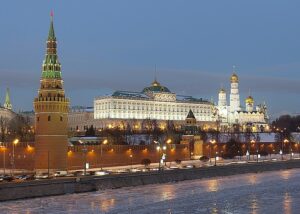 On February 24, 2022, the Kremlin launched a “special military operation” with the stated aim of completely eliminating Ukraine’s independence as a state and society. The decision by Russian president Vladimir Putin came as a surprise to many observers, as few experts had envisaged such a scenario. Their predictions were often clouded by the prevailing belief that Russia had no “objective motivation” for engaging in a war of this magnitude. Soon after, when Russian forces encircled Kyiv, those who had initially argued that these troops would not cross the Ukrainian border began to argue that Russia simply had no other alternative. They claimed that the invasion was due to pressure from “the West.”
On February 24, 2022, the Kremlin launched a “special military operation” with the stated aim of completely eliminating Ukraine’s independence as a state and society. The decision by Russian president Vladimir Putin came as a surprise to many observers, as few experts had envisaged such a scenario. Their predictions were often clouded by the prevailing belief that Russia had no “objective motivation” for engaging in a war of this magnitude. Soon after, when Russian forces encircled Kyiv, those who had initially argued that these troops would not cross the Ukrainian border began to argue that Russia simply had no other alternative. They claimed that the invasion was due to pressure from “the West.”